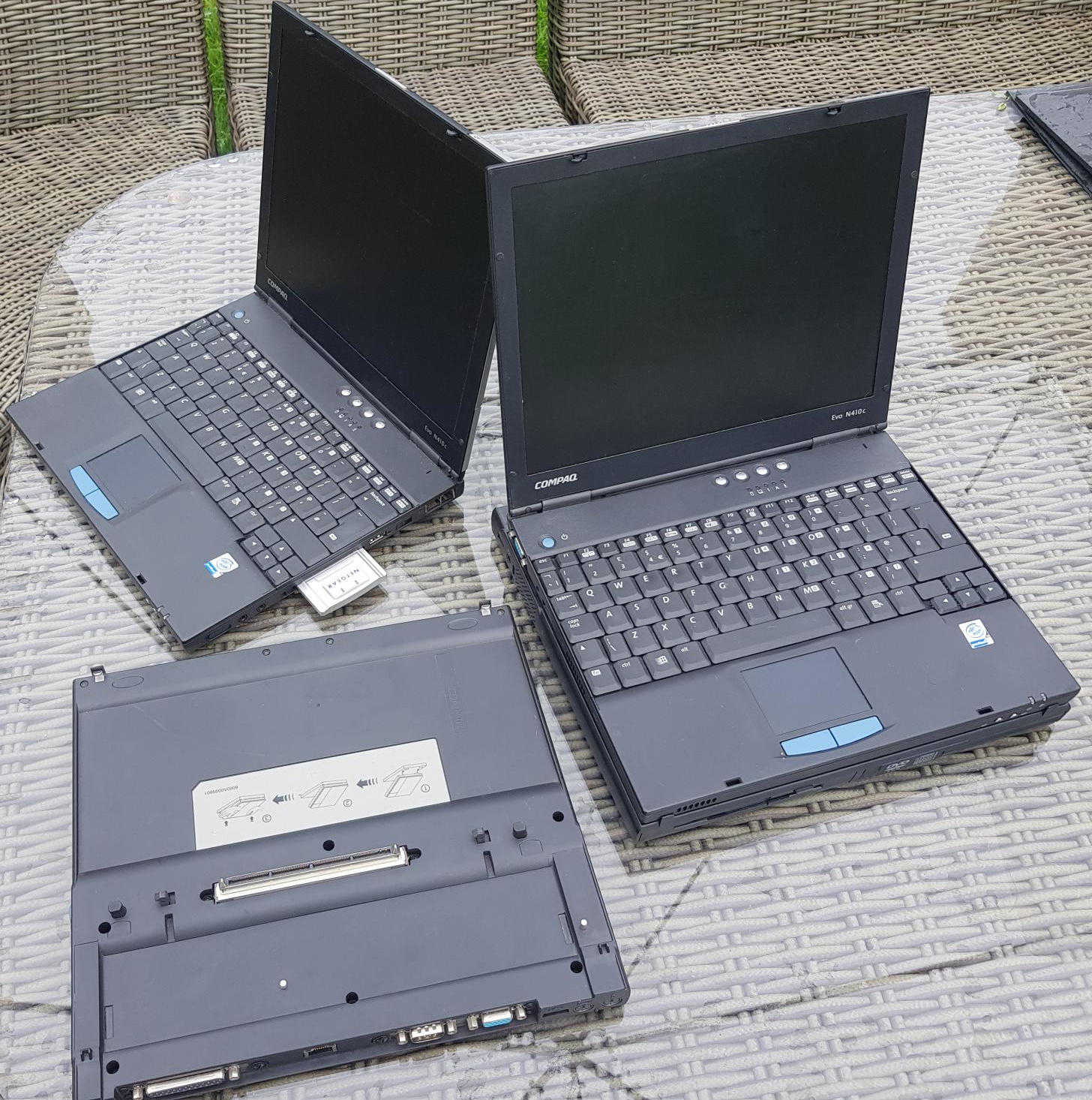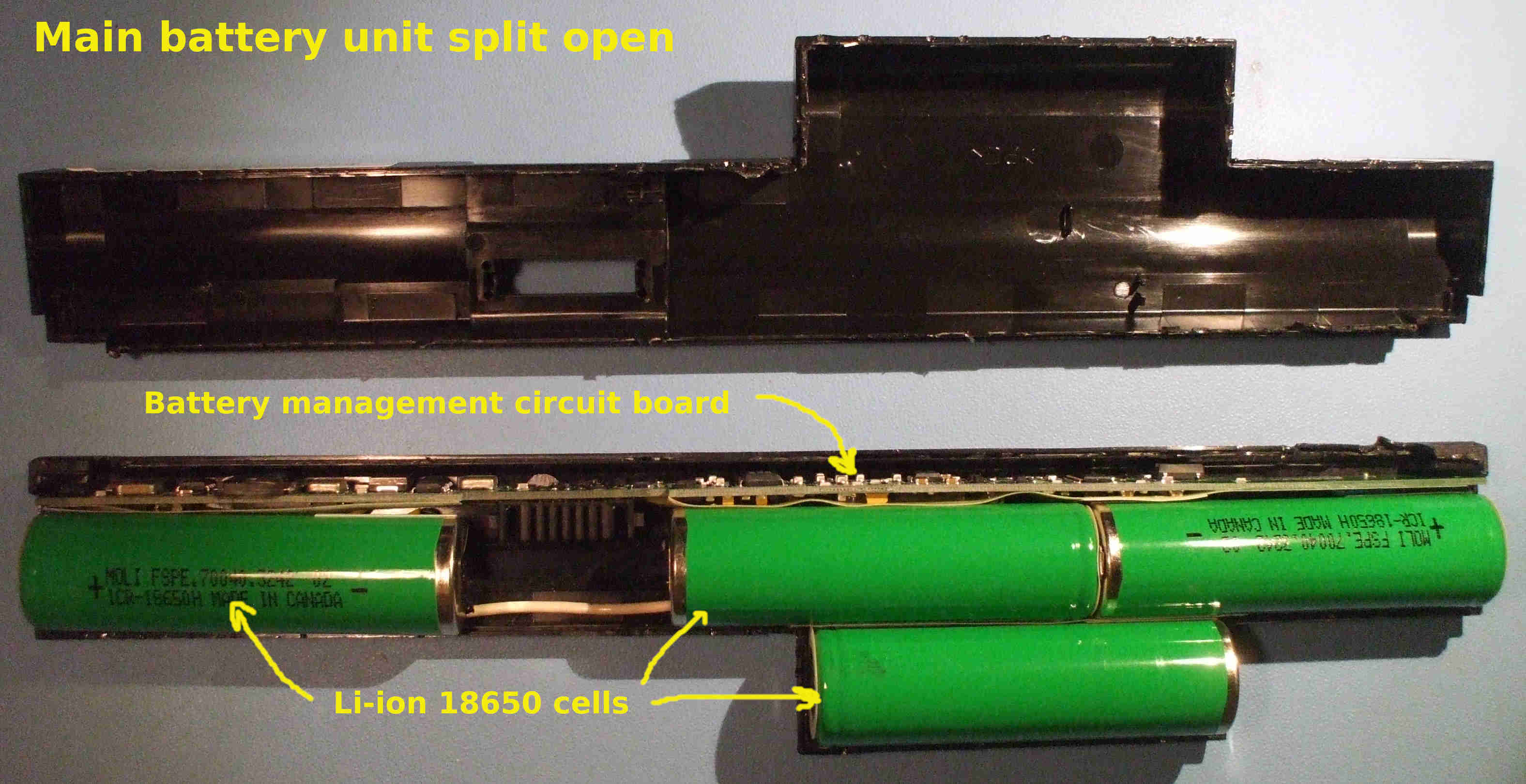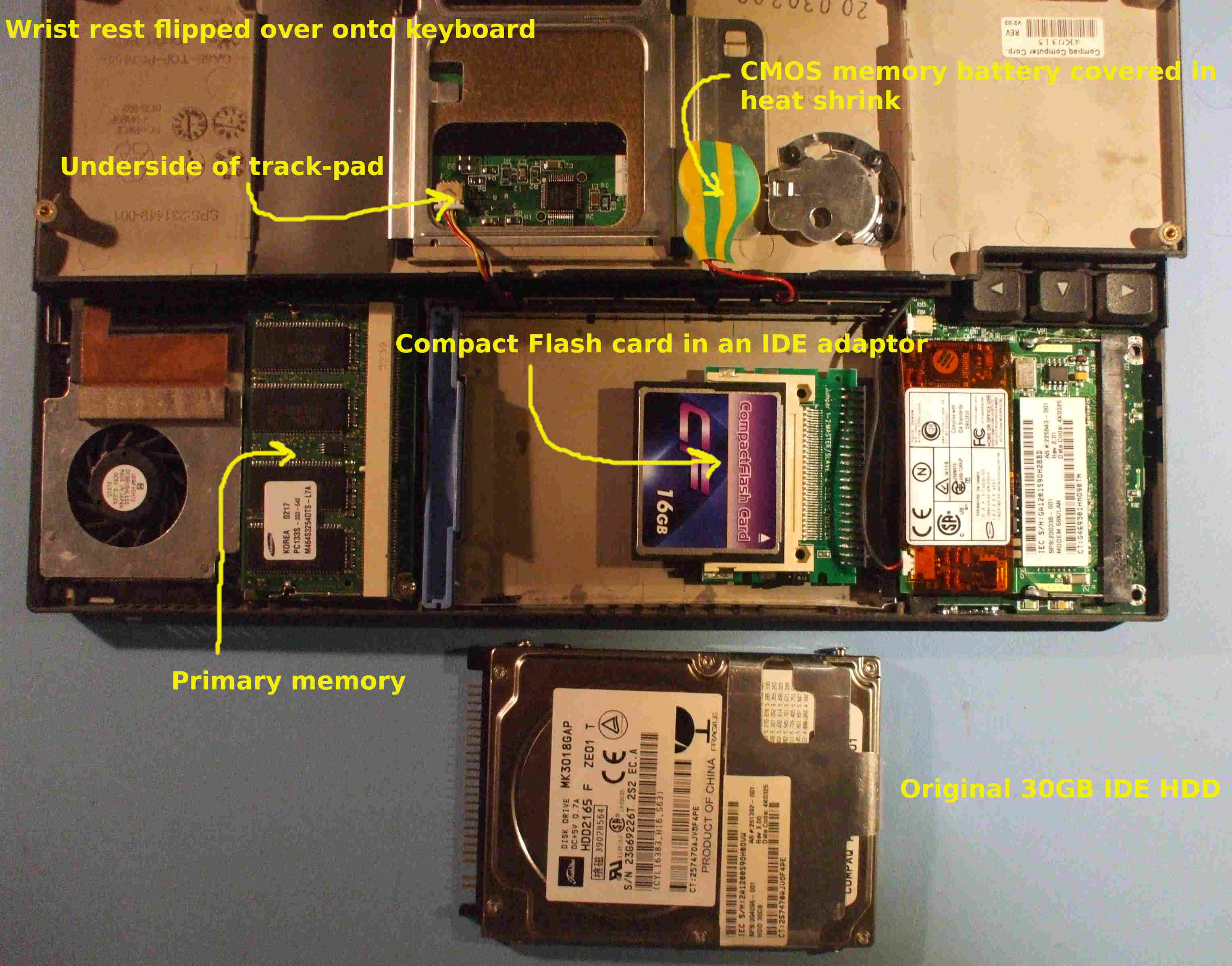Compaq Evo N410c —
Giving an old notebook a new lease of life.
Released in 2002 a Compaq Evo N410c notebook, plus Mobile Expansion Unit (with DVD and floppy disk drives) and a rear battery add-on would have cost around $2,400 (and probably the same amount in pounds sterling, because trans-Atlantic exchange rates never seem to apply to technology?).
But allow for 20 years of depreciation and I gratefully picked up the same for just £10 at a computer jumble. Despite dead batteries it was working and in good physical condition.
Thinking I may need spares, I also bought a non-working model, complete with same expansion unit and drives for £20 on eBay. Yes, I paid twice as much for a broken one!
Whilst I am keen to keep old tech out of landfill, I wouldn’t class the N410c as a classic. So it wasn’t intended for my Silicon Heaven museum but it could qualify if it was obsolete (yes), yet still interesting and useful (to be proven?).
My real intention was to find a cheap, small form-factor notebook that had plenty of interfaces for connecting to projects and old equipment.
Cheap – because there’s always a possibility of my projects damaging any connected computer!
Small – so it wouldn’t take up much workbench space and could be easily shelved when not in use.
Interfaces – because you don’t get many on devices these days and I wanted to retain something capable of old school serial and parallel comms.
Interfaces again – because even media drives for 3½-inch floppies, DVDs and CDs are quietly going extinct.
The Basic Specs
This post isn’t intended to be a comprehensive review of this notebook. As I said, it’s no classic, and I really couldn’t say how it compared to its peers. It simply met my minimal requirements at a reasonable price.
Processor – Pentium III 1.2GHz
Memory – 256MB to 1GB max
Hard drive – 30 GB IDE/EIDE (ATA-5 to be precise)
Size – 26.6 x 24.2 cm and 1.58kg
Screen size – 12.1″ XGA TFT (max resolution 1024 x 768)
And lots of ports:
RJ45 10/100 Ethernet,
RJ11 internal 56Kbps modem,
a PCMCIA slot that supports 16 & 32-bit cards,
2 x USB 2.0,
Infrared (IrDA),
headphone & microphone jacks,
MultiPort option for Bluetooth or Wi-Fi (hidden inside the screen housing, although I’ve yet to see any of these modules),
VGA and TV-out (composite video jack),
Parallel and Serial ports
And that’s just the notebook. Once it is docked into a Mobile Expansion Unit (MEU), which has basically the same footprint and sits underneath the notebook, you also get:
RJ45 10/100 (NIC passthrough),
Parallel, Serial, VGA, microphone & headphone jack port replication,
2 additional USB sockets and PS2 connectors for mouse and keyboard,
2 x drive bays for which I have 1.44MB floppy disk and DVD-ROM drives in both of my MEU’s.
Note that passthrough or replicated ports are not additional interfaces but an extension/replacement for the notebook’s ports. They therefore don’t give additional connectivity but they do allow for an MEU to be wired-up to a project and for different notebooks to be easily docked with that setup.
So these notebooks are well equipped. Released in the same year that HP acquired Compaq, the 2002 HP website stated the “N410c is the power packed Ultraportable with extraordinary capabilities. Designed with the highly mobile professional in mind”
Repairs
The main repair would appear to be the notebook that was purchased on eBay as “Parts Not Working/Spares/Repair”. That turned out to be just a dead external power supply. The notebook worked fine with another PSU and was otherwise in good condition.
It’s worth noting that the PSU provides 18.5V, is rated at 65W and the centre positive plug for the notebook is 4.8 * 1.7mm (outer and inner measurements).
My original working model had a couple of hardware issues. Firstly there was something rattling around inside. Never a good sign and not something that can be ignored as a short-circuit could occur at any time and cause irreparable damage.
This turned out to be a metal clip broken from the front of the notebook. Not an essential feature, it strengthens the notebooks connection to the MEU but works fine without it.
The 2nd issue was that this notebook had definitely been worked on before. There were no obvious signs of any mods or repairs but all the underside Torx screws had been mangled by a non-Torx screwdriver and were almost undo-able. Fortunately I managed to remove them all and replaced them with 6mm M2 posidriv screws.
The CMOS/RTC (real time clock) battery was dead in both notebooks. Not essential to replace but annoying that they set the date to 1980 each time they were booted. The service manual (found online at archive.org) states battery removal will clear any BIOS password but other BIOS settings (such as boot sequences) are not affected.
This battery is a CR2016 found on the underside of the wrist-rest at the front of the keyboard.
Rather than attempt to solder tags to a coin cell battery and risk damaging it, I bought cells intended for PCB mounting, so they already had tags attached. I soldered those tags to the battery cable and wrapped the whole cell and connections in large heat-shrink tubing before re-inserting under the wrist-rest.
Lithium-Ion Batteries
Spoiler alert – this did not go well but I’ve included the story here as a warning…
All the battery cells in both notebooks were completely dead and would not hold any charge. That’s the 4 cells in the internal battery (underside-rear of the notebook) and the 4 cells in the rear add-on ‘handle’ battery. Some were even corroded but I suspect that could be due to the pack sitting in water/coffee rather than cells leaking.
Easy, I thought, replace the dead cells and each battery pack will have a new lease of life… So I embarked on a voyage of discovery – 18650 + 26650 Li-ion cells, battery spot welding, thermal sensors, smart battery fuses, BIOS battery calibrations, ACPI and lots of testing.
Each time I achieved a successful charge and 2hrs+ of battery operation, I found I couldn’t repeat the exercise. The only consistent results were that the notebooks would not boot on battery power. But if booted via the mains (just to the BIOS menu) the external PSU could then be disconnected and the notebooks would run fine on their batteries.
But by this time I had lost my nerve… There was no way that I would ever leave these notebooks plugged in and unattended. What if they over-charged and over-heated!
Although frustrated by the Smart Battery System within each battery pack and the way they prevent replacements once cells reach their end of life. I do appreciate why they’re preventing enthusiastic amateurs like me from creating potential fire bombs.
I suspect that if cells had been replaced before these battery packs had completely died then I may have had better luck. But I don’t want to rely on luck for something so potentially dangerous.
Maybe I could just buy complete replacement battery packs? Well although some suppliers still list them for these old notebooks, they never had any in stock.
As my aim is to use these notebooks on the workbench where a mains supply is readily available, I shall simply go without battery backup. So I’ve safely removed all cells and left the battery packs disconnected.
It was however an interesting dive into the world of Smart Battery Systems and I’m sure my new battery spot-welding skills will come in useful one day.
Memory
The primary memory stick socket can be found under the wrist rest and a second ‘memory expansion’ slot can be found underneath the notebook.
Both notebooks came with the standard 256MB in primary and my original one also had 128MB in its expansion slot.
Maximum RAM capacity for the N410c is 1024MB (two 512MB sticks) and I did want them to run quickly but I wasn’t intending to invest too much money.
When searching for memory specifically for the N410c prices ranged from £25 to £62 for a 512MB stick. A useful tip is not to search for the computer model but for the required memory specification instead. In this case “512MB PC133 133Mhz 144-pin laptop memory RAM SODIMM” resulted in sticks for just £8.99.
I didn’t ‘max out’ the notebooks but settled for 512MB in the expansion slot. Giving 768MB in total which tested ok.
Both N410c’s came with 30GB hard drives ATA-5(IDE) and tested ok but the one in my original notebook was much noisier and probably on its way out.
Due to the age I couldn’t just drop-in a SATA SSD but I could use a Compact Flash card. A downgrade in capacity but a performance improvement and silent running!
A Compact Flash to 44 pin IDE adapter was necessary. When buying remember that laptops use a 44 pin IDE connection because it also carries power, whereas a desktop computer will use a 40 pin IDE connector and have power wired separately.
A new 16GB Compact Flash card was £13.50 and the adapter cost £5. Used memory cards are cheaper but you can’t be sure how frequently they’ve been used and so how much life they have left.
Swapping Hard Disk for Flash couldn’t be easier. Just a matter of unplugging one (under the notebook wrist rest) and plugging in the other. I then needed to boot into an operating system via CD before deciding which OS to load onto the Flash card.
.
Operating Systems
I’d better start by confessing that I’ve left Windows XP on one of the notebooks.
Whilst I’m usually keen to delete Windoze at the first opportunity, I’ve relented this time because… It’s on a spare notebook that I won’t be using much; it’s period correct for this 2002 notebook; I’ll keep it secure by limiting connectivity within my network; And it’s sometimes handy to witness hardware being controlled (as intended) from Windows in order to troubleshoot Linux alternatives.
For the other notebook I have tested booting into my own FernOS operating system from 3.5″ floppy and into my old favourite Puppy Linux from CD. Unfortunately the N410c doesn’t support booting from USB.
Whilst there is a wonderful world of Linux distros to explore, my tastes these days are pure Debian or at least a Debian based distro so that I don’t have to re-learn too much, especially package management. Due to the limited system specs I also needed something very light weight, 32-bit compatible, yet up to date.
I opted for antiX, it’s an impressive lightweight distro that works very well with old or low spec computers. It’s also very configurable so you can make of it whatever you wish.
Actually it’s so keen to be configurable that it comes with many (sometimes competing) options installed as default. e.g. a choice of 13 window managers when just JWM will do for me (something familiar from my Puppy Linux days).
Boot time to Windoze XP was 4 minutes 12 seconds (were we really that patient back in 2002?). antiX boot time is now 44 seconds. I’m sure I could tune that further but sometimes you just have to admit that is good enough and move on…
Networking
No problems connecting to my LAN via an RJ45 patch cable but my first notebook came with a PCMCIA Wi-Fi card (NetGear WG511T – 108Mbps to be precise) and that was quite a palaver to get working reliably, particularly DNS.
I eventually realised that the Base edition of antiX comes with both ceni and connman network managers but they won’t play nicely together. So, having had some success with ceni to initially connect to Wi-Fi, I chose to remove connman.
1. remove connman – sudo apt remove connman
2. also found I needed to delete the connman config directory – rm /etc/conman
3. and create a fresh DNS config file – rm /etc/resolv.conf
4. sudo ln -s /etc/resolvconf/run/resolv.conf /etc/resolv.conf
5. run ceni and setup wlan0:
If done correctly then the /etc/resolv.conf should contain the IP of your DNS nameserver
Intended to be cheap (disposable even) workbench notebooks but I couldn’t resist giving them some care and attention and will now be upset should I break one.
Categorised as: Computer Stuff | Silicon Heaven
Comments are disabled on this post


